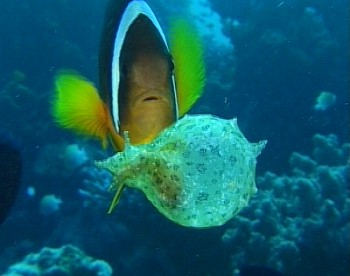
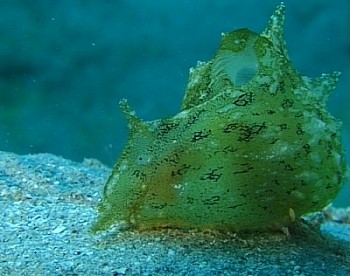
Notarchus indicus
Schweigger, 1820
Order: ANASPIDEA
Superfamily: APLYSIOIDEA
Family: Aplysiidae
DISTRIBUTION
Indo-West Pacific. Reported to have migrated into Mediterranean through Suez Canal.
PHOTO
ROYAL Diving Center, Akaba, Jordan. Red Sea. 15m., April 2000. Upper photo showing Notarchus swimming. Photos: Jochen Scholtyssek.
Notarchus is a genus of Sea Hare in which the parapodia are almost completely fused. There is a small anterior opening to allow an exchange of water to the mantle cavity. They have no shell. They are able to escape from danger by swimming by jet propulsion. A most spectacular if inelegant display which I have described in a message below.
There are two described species, Notarchus punctatus with an armed penis and Notarchus indicus without. N. punctatus is recorded from the Mediterranean, Caribbean and curiously Japan. Notarchus indicus is known from much of the Indo-West Pacific under various names.
See Jochen's photos and my descriptiion of swimming behaviour below.
See second message with further photos.
Reference:
• Schweigger, A.F. (1820) Handbuch der Naturgeschichte der skelettlosen ungegliederten Thiere. Leipzig.
Rudman, W.B., 2000 (June 27) Notarchus indicus Schweigger, 1820. [In] Sea Slug Forum. Australian Museum, Sydney. Available from http://www.seaslugforum.net/find/notaindi
Related messages
Re: Notarchus indicus at Eilat
February 17, 2006
From: Binyamin Koretz

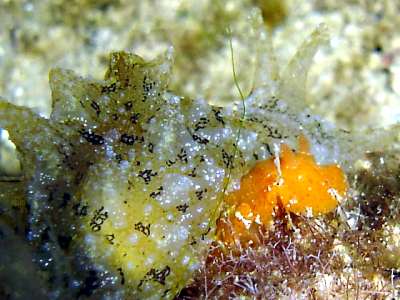
Concerning message #13325:
Dear Bill,
In your earliery message you referred to a report from the 1970's concerning an observed population explosion of Notarchus indicus in Eilat. It's happening again right now!
In 2005, following a big influx of algae, we saw a moderate number of individuals over the course of the spring (March, April, May), all of them at night, and only at one dive site with a lot of thick seagrass around the sporadic coral heads. Then none for about 8 months, although we dived this site at night every week or two. As recently as 4 weeks ago, we still saw none. Then the algae started to return, and 2 weeks ago we counted 4 in one dive. Last night we saw dozens, perhaps hundreds, in one dive.
The one in front of my hand [lower photo] had just tumbled in front of me as I was finning - in its peculiar swimming motion. Another one crawled blithely across the back of a tiny (7 mm) Sclerodoris tuberculata. And among the many pairs you could see the range of coloration from creamy white to bright amber.
Locality: Eilat, Satil Area, 22-24m, Israel, Red Sea (Gulf of Eilat), 11 February 2006 (night), sea grass and patch reef. Length: up to 3 cm. Photographer: Binyamin and Shulamit Koretz
Best regards
Binyamin Koretz
binyamin@koretz.net
Koretz, B., 2006 (Feb 17) Re: Notarchus indicus at Eilat. [Message in] Sea Slug Forum. Australian Museum, Sydney. Available from http://www.seaslugforum.net/find/15835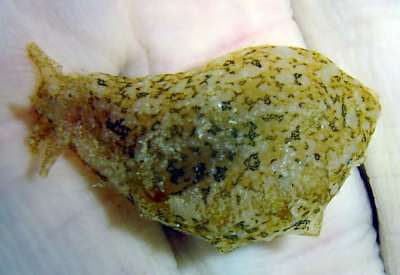
Dear Binyamin,
Their swimming behaviour must make them the clowns amongst the Sea Hares. I look forward to further observations
Best wishes,
Bill Rudman
Notarchus indicus at Eilat
March 15, 2005
From: Bill Rudman
While checking out a Melibe reference I came across this reference to a large population of Notarchus indicus at Eilat, Red Sea. Schuhmacher (1973) describes in some detail the characteristic 'tumbling' behaviour I described in my comments on Jochen Scholtyssek's photos [#2633, #2658]. This paper complements Martin's study of swimming of Notarchus punctatus in the Mediterranean.
- Martin, R. (1966) On the swimming behaviour and biology of Notarchus punctatus Philippi (Gastropoda, Opisthobranchia). Pubbl. Staz. Zool. Napoli, 35: 61-75.
- Schuhmacher, H. (1973) Notes on occurrence, feeding, and swimming behaviour of Notarchus indicus and Melibe bucephala at Elat, Red Sea (Mollusca: Opisthobranchia). Israel Journal of Zoology, 22: 13-25.
Bill Rudman
Rudman, W.B., 2005 (Mar 15) Notarchus indicus at Eilat. [Message in] Sea Slug Forum. Australian Museum, Sydney. Available from http://www.seaslugforum.net/find/13325Re: Notarchus from Hawaii
August 3, 2000
From: John Hoover
Bill,
Thanks for your reply. Notarchus looks right.
It turns out that Cory Pittman had already recorded it from here.
Aloha,
John
jhoover@hawaii.edu
Hoover, J., 2000 (Aug 3) Re: Notarchus from Hawaii. [Message in] Sea Slug Forum. Australian Museum, Sydney. Available from http://www.seaslugforum.net/find/2825Strange Sea Hare from Hawaii
August 2, 2000
From: John Hoover
Dear Dr. Rudman,
My friend Darrell Takaoka found a sea hare that looks much like Stylocheilus longicauda [i.e. S. citrina]. It is orange-yellow with scattered small black spots and a short tail visible only when the slug stretches out. It has scattered papillae with whitish tips. There are no parapodia.
In its normal resting position it appears round except for the head. It has the habit of squirting water from the orifice on its back as if trying to propel itself down and backwards. Darrell collected it in 2 feet of water on seaweed covered rock at Ala Moana Beach Park, Honolulu.
Because it lacks a long tail we suspect it is not S. longicauda, but what then is it?
Thanks,
John Hoover
Honolulu, Hawaii
jhoover@hawaii.edu
Hoover, J., 2000 (Aug 2) Strange Sea Hare from Hawaii. [Message in] Sea Slug Forum. Australian Museum, Sydney. Available from http://www.seaslugforum.net/find/2808Dear John,
If it looks like a sea hare, doesn't have parapodia, and squirts water from its 'orifice' then the only thing that fits is Notarchus indicus.
Notarchus indicus is the amazing sea hare which swims by jet propulsion. It does have parapodia, but they are fused except for a small section which forms the orifice you mention.
Have a look at the page on Notarchus and the wonderful series of photos from the Red Sea that Jochen Scholtyssek recently sent us in two messages.
If your animal looks nothing like Notarchus then I guess you had better send a photo or a sketch so I have a few more clues.
Best wishes,
Bill Rudman.
More photos of Notarchus swimming
July 6, 2000
From: Jochen Scholtyssek
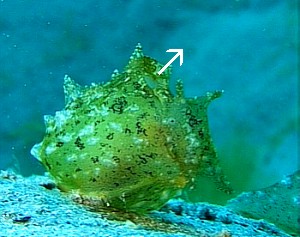
Dear Bill,
Here are some more Video-Pictures for you of Notarchus indicus swimming in the Red Sea.
Best wishes,
Jochen Scholtyssek
joscholty@t-online.de


Dear Jochen,
Thanks very much. I have included three of the ones you sent, showing take-off and swimming. They make a nice addition to your earlier photos.
I have included an arrow in each photo to show whether Notarchus is sucking water in, or squirting it out, through the single opening into its parapodial cavity.
Upper right: Notarchus squirting water out as it begins to 'swim.'
Lower left: sucking water in as it tumbles over.
Lower right: jetting water out in forward propulsion.
Best wishes,
Bill Rudman
Notarchus indicus swimming
June 28, 2000
From: Jochen Scholtyssek


Dear Bill,
I took this Video in the Red Sea at a daydive in April 2000.
ROYAL Diving Center, Akaba, Jordan. Depth 15m.
I have no idea of it`s ID. - Aplysia dactylomea? Anaspidea? German:Seehase?
Jochen Scholtyssek
56170 Bendorf-Sayn
Hellenpfad 30
Germany
joscholty@t-online.de
Scholtyssek, J., 2000 (Jun 28) Notarchus indicus swimming. [Message in] Sea Slug Forum. Australian Museum, Sydney. Available from http://www.seaslugforum.net/find/2633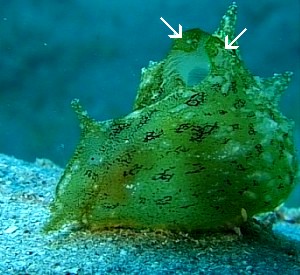
Dear Jochen,
This is definitely an Anaspidean or Sea Hare but it is a bit more interesting than Aplysia dactylomela.
It is a species of Notarchus, Sea Hares which are able to swim by jet propulsion, as your animal is doing in the top photo. In most Sea Hares the parapodia are large flaps on the side of the body which fold over to enclose the reduced and flattened shell and mantle cavity. [See the page on Syphonota geographica for a good photo of a typical Sea Hare with opened parapodia showing the mantle cavity]. Some species are able to swim by flapping the parapodia a bit like a bird uses its wings [See photo of Aplysia extraordinaria swimming]. The parapodia in Notarchus however, are fused together, except for a small opening at the anterior end. The fused parapodia mean that the body of Notarchus is effectively enclosed in its own bag or sac. In the following description of how it swims, I will call the cavity enclosed by this parapodial sac the parapodial cavity. The small section of unjoined parapodial edge at the opening to the parapodial sac have become small lobes [see arrows in your photo alongside]. These two lobes control the movement of water in and out of the parapodial sac. When Notarchus is crawling, or at rest, water for breathing is directed in and out of the parapodial sac between the two lobes. In normal Sea Hares the parapodial edge forms a temporary anterior inhalent siphon to direct water into the mantle cavity and a temporary posterior exhalent siphon to expel deoxygenated water. Because the opening is so small in Notarchus, it has to take turns at being both the inhalent and exhalent siphon. When water is being drawn into the cavity, the two mantle lobes fold down over the back of the parapodial opening so water is sucked in anteriorly. When water is being expelled the flaps close over the anterior end so water is expelled posteriorly.
However when the animal is disturbed and feels the urgent need to escape, the lobes join to form a funnel around the whole of the parapodial opening, quickly drawing in enough water to blow up the parapodial cavity so the slug looks like a balloon [see your upper photo]. When the cavity is 'full', the lobes fold down over the parapodial opening to leave only a narrow posterior funnel. The parapodial lobes quickly contract and the water is expelled in a strong jet, propelling the animal up off the bottom. As it rises, water is again sucked into the cavity, and when fully expanded, it is again jetted out, keeping Notarchus swimming. During this swimming phase, Notarchus undergoes a series of backward somersaults. The result is quite spectacular, if not very elegant. It is clearly designed to quickly remove Notarchus from a place of immediate danger, rather than as a means of serious movement from one place to another.
If you have other photos of this animal swimming I would very much like to see them.
There are two species of Notarchus which can only be satisfactorily separated by looking at their reproductive system - Notarchus punctatus has penial spines, and N. indicus does not. Since your animal is from the Red Sea, I think it is most probably Notarchus indicus. If you would like some more general information on Sea Hares go to the Sea Hares Page.
Reference: Martin, R. (1966) On the swimming behaviour and biology of Notarchus punctatus Philippi (Gastropoda, Opisthobranchia). Pubbl. Staz. Zool. Napoli, 35: 61-75.
Best wishes,
Bill Rudman.
